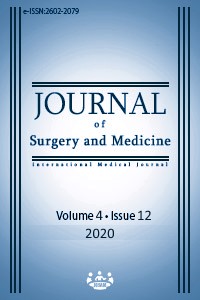Melatonin prevents post-traumatic ischemic damage in rats
Keywords:
Melatonin, Traumatic Brain Damage, Secondary Injury, Ischemic InjuryAbstract
Aim: Brain trauma is among the leading causes of mortality and long-term disability in the world. Studies suggested that cerebral ischemia is an important mechanism of secondary neuronal injury in traumatic brain injury (TBI), and that melatonin has protective effects on the brain after trauma. It was also shown that melatonin alleviates the formation of cerebral ischemia and ischemic brain damage in many cerebral pathophysiological processes. However, there is no study which investigates the effects of melatonin on cerebral ischemia after brain trauma. Therefore, we aimed to induce experimental focal brain trauma in rats and assess the effects of melatonin on posttraumatic cerebral ischemia. Methods: The animals used in this research were divided into four groups as follows: Control group (Group 1), Traumatic Brain Injury (TBI) group (Group 2), TBI plus Placebo group (Group 3), and TBI plus Melatonin group (Group 4). Brain trauma was induced using the weight drop technique in all groups except the Control group (Group 1). The groups with induced brain trauma were separated into five sub-groups to be sacrificed at the given times (12, 24, 72, 120 and 168 hours). Hematoxylin and eosin (H&E) staining was applied to count the number of red neurons, which indicate the grade of cerebral ischemia. Results: Our results showed that the number of red neurons was significantly less (P<0.05) in the melatonin-treated groups compared to those in the trauma and placebo groups within the same amount of time. Conclusion: The present study found that melatonin markedly inhibits the progression of cerebral ischemia after brain trauma. Therefore, melatonin can be used as a potential therapeutic agent to prevent posttraumatic secondary cerebral injuries. However, further studies are needed to investigate the mechanism of its effect.
Downloads
References
Cunningham AS, Salvador R, Coles JP, Chatfield DA, Bradley PG, Johnston AJ, et al. Physiological thresholds for irreversible tissue damage in contusional regions following traumatic brain injury. Brain. 2005;128:1931–42. doi: 10.1093/brain/awh536
Werner C, Engelhard K. Pathophysiology of traumatic brain injury. Br J Anaesth. 2007;99:4–9. doi:10.1093/bja/aem131
Coles JP, Fryer TD, Smielewski P, Rice K, Clark JC, Pickard JD, et al. Defining ischemic burden after traumatic brain injury using 15O PET imaging of cerebral physiology. J Cereb Blood Flow Metab. 2004;24:191–201. doi: 10.1097/01.WCB.0000100045.07481.DE.
Coles JP, Fryer TD, Smielewski P, Chatfield DA, Steiner LA, Johnston AJ, et al. Incidence and mechanisms of cerebral ischemia in early clinical head injury. J Cereb Blood Flow Metab. 2004;24:202–11. doi: 10.1097/01.WCB.0000103022.98348.24.
Oertel M, Boscardin WJ, Obrist WD, Glenn TC, McArthur DL, Gravori T, et al. Posttraumatic vasospasm: the epidemiology, severity, and time course of an underestimated phenomenon: a prospective study performed in 229 patients. J Neurosurg. 2005;103:812–24. doi: 10.3171/jns.2005.103.5.0812
Bramlett HM, Dietrich WD. Pathophysiology of cerebral ischemia and brain trauma: similarities and differences. J Cereb Blood Flow Metab. 2004;24:133–50. doi: 10.1097/01.WCB.0000111614.19196.04.
Kunz A, Dirnagl U, Mergenthaler P. Acute pathophysiological processes after ischaemic and traumatic brain injury. Best Pract Res Clin Anaesthesiol. 2010;24(4):495-509. doi: 10.1016/j.bpa.2010.10.001.
Tsai MC, Chen WJ, Tsai MS, Ching CH, Chuang JI. Melatonin attenuates brain contusion-induced oxidative insult, inactivation of signal transducers and activators of transcription 1, and upregulation of suppressor of cytokine signaling-3 in rats. J Pineal Res. 2011;51:233-45. doi: 10.1111/j.1600-079X.2011.00885.
Aladag MA, Turkoz Y, Parlakpinar H, Ozen H, Egri M, Unal S C .Melatonin Ameliorates Cerebral Vasospasm After Experimental Subarachnoidal Haemorrhage Correcting Imbalance of Nitric Oxide Levels in Rats. Neurochem Res. 2009 Nov;34(11):1935-44. doi: 10.1007/s11064-009-9979-7.
Ramos E, Patiño P, Reiter RJ, Gil-Martín E, Marco-Contelles J, Parada E, et al. Ischemic brain injury: New insights on the protective role of melatonin. Free Radic Biol Med. 2017;104:32-53. doi: 10.1016/j.freeradbiomed.2017.01.005.
Feeney DM, Boyeson MG, Linn RT, Murray HM, Dail WG. Responses to cortical injury: I. Methodology and local effects of contusions in the rat. Brain Res. 1981;211:67-77.
Leesta JE. The anemic pole infarction in forensic neuropathology. Second Edition.2009. CRC Press. Taylor&Francis group. USA. pp. 115-117. ISBN-13-978-0-8493-9167-5
Sun L, Kuroiwa T, Ishibashi S, Katsumata N, Endo S, Mizusawa H. Transition of areas of eosinophilic neurons and reactive astrocytes to delayed cortical infarcts after transient unilateral forebrain ischemia in Mongolian gerbils. Acta Neuropathol. 2006;111:21–8. doi: 10.1007/s00401-005-1081-x.
Ginsberg MD, Zhao W, Alonso OF, Loor-Estades JY, Dietrich WD, Busto R. Uncoupling of local cerebral glucose metabolism and blood flow after acute fluid-percussion injury in rats. The Am J Physiol. 1997;272(6 Pt 2):H2859–68. doi: 10.1152/ajpheart.1997.272.6.H2859.
Inoue Y, Shiozaki T, Tasaki O, Hayakata T, Ikegawa H, Yoshiya K, et al. Changes in cerebral blood flow from the acute to the chronic phase of severe head injury. J Neurotrauma. 2005;22:1411–8. doi: 10.1089/neu.2005.22.1411.
Tavazzi B, Signoretti S, Lazzarino G, Amorini AM, Delfini R, Cimatti M, et al. Cerebral oxidative stress and depression of energy metabolism correlate with severity of diffuse brain injury in rats. Neurosurgery. 2005;56:582–9. doi: 10.1227/01.neu.0000156715.04900.e6.
Ramos E, Patiño P, Reiter RJ, Gil-Martín E, Marco-Contelles J, Parada E, et al. Ischemic brain injury: New insights on the protective role of melatonin. Free Radic Biol Med. 2017;104:32-53. doi: 10.1016/j.freeradbiomed.2017.01.005.
Beni SM, Kohen R, Reiter RJ, Tan DX, Shohami E. Melatonin-induced neuroprotection after closed head injury is associated with increased brain antioxidants and attenuated late-phase activation of NF-kappaB and AP-1. FASEB J. 2004;18:149-51. doi: 10.1096/fj.03-0323fje.
Downloads
- 284 587
Published
Issue
Section
How to Cite
License
Copyright (c) 2020 Cengiz Gölçek, Mehmet Arif Aladağ, Harika Gözükara
This work is licensed under a Creative Commons Attribution-NonCommercial-NoDerivatives 4.0 International License.
















